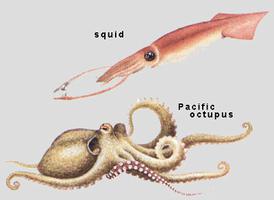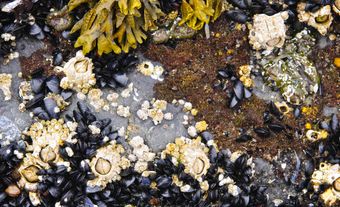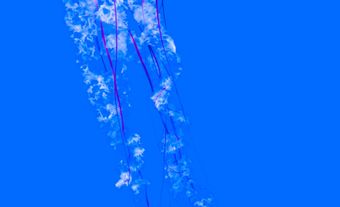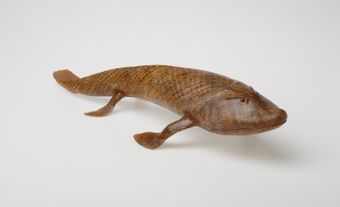The mollusc is a soft-bodied, usually shelled invertebrate belonging to one of the largest animal phyla (Mollusca) with some 100 000 living and about 35 000 fossil species. Molluscs are found on land and in salt and fresh water, and include snails, abalone, clams, mussels, octopuses and squid. Molluscs range from some of the smallest invertebrates (snails and clams, measured in millimetres) to the largest (giant squid, up to 15-20 m long). The group is characterized by a muscular foot on which the animals creep; a calcareous shell secreted by the underlying fleshy mantle; and a feeding structure, the radula, consisting of a membrane, bearing sharp cusps, thrusting out from the mouth (found in all major groups except Bivalvia).
Food particles (plant or animal tissue) are rasped on the inward or return stroke and are borne into the gullet and through the alimentary tract in grooves lined with cilia (hairlike projections). Bivalves feed mainly on waterborne food particles, captured by a mucus-filtering system formed from the gills. Mollusc shells consist of calcium carbonate crystals (sometimes with magnesium carbonate) interspersed in an organic framework. The mineralized shells have left a rich fossil history dating back to the earliest evidence of animal life.
The ancestral mollusc is thought to have been a small, creeping, bilaterally symmetrical inhabitant of ocean shallows, bearing a shield-shaped shell. It ate fine algae scraped from rocks. Seven major classes of living molluscs evolved: Monoplacophora, Polyplacophora (chitons) and Gastropoda (snails) most closely resemble the primitive form; Aplacophora, Scaphopoda (tusk-shells), Bivalvia (clams) and Cephalopoda (octopuses) represent more radical divergences from the ancestral type. Molluscs, because of their diverse and often beautiful shell shapes, accessibility, and importance as food and disease vectors, have played important cultural and economic roles in human history. Malacology studies the diversity, classification and evolution of molluscs. A brief discussion of the 7 major molluscan classes follows.
Monoplacophora
Monoplacophora, small class comprising some 7 species in genus Neopilina; no Canadian species are known. First discovered live in 1952 from deep-dredge collections off the Pacific coast of Costa Rica, these small (0.3-3 cm long) animals were hitherto known only from fossils of the Cambrian period (570-505 million years ago). Their primitive features, eg, single, shield-shaped shell (hence, name Monoplacophora), poorly developed head, and repetitive systems of paired kidneys, gills and foot retractor muscles, suggest that Monoplacophora represent one of the earliest molluscan groups. They are adapted for life at great depths and eat unicellular plants and animals and sponge material grazed from the sea bottom.
Polyplacophora
Polyplacophora, the chitons, marine class comprising some 600 living species, ranging from a few centimetres or less to over 30 cm long. The name, meaning "bearer of many plates," refers to the 8 distinctive, overlapping shell-plates. The protective shell and broad, adhesive foot permit life on rocks in wave-disturbed intertidal zones. They eat unicellular algae, scrapings from seaweeds and occasionally animal matter. The poorly developed head, rudimentary nervous system, primitive larval form and multiple gills suggest that chitons diverged early from the main line of molluscan evolution. The gum-boat chiton (Cryptochiton) of the Canadian West Coast is one of the world's largest chitons.
Gastropoda
Gastropoda, the largest molluscan class, with 75 000 living and about 15 000 fossil species, includes some of the most common invertebrates: limpets, abalones, periwinkles, conchs, whelks, slugs and snails. Gastropoda are harvested and cultured for food worldwide. Certain freshwater snails are important disease vectors, acting as intermediate hosts for liver and blood flukes that parasitize humans (eg, schistosomiasis). Snail shells are prized for their form and beauty. Gastropods occupy more habitats and represent more species than any other molluscan class. This extensive adaptive radiation was made possible through 3 major changes from the molluscan ancestral plan: development of a complex head with elaborate receptors and nervous system; coiling of shell; and torsion, involving a 180° twisting of the shell and visceral mass over the lower body section.
Coiling and torsion evolved independently. Coiling probably preceded torsion, converting the ancestral shell from a simple, flattened shield to a fully protective retreat. The earliest form of coiled shell (found only in extinct species) was planospiral, ie, each spiral lying outside of the preceding one in the same plane (eg, like a coiled rope). This large, unwieldy and probably unbalanced shell was improved by evolution of asymmetrical coiling about a central axis. The new shell had its centre of gravity squarely over the body midline. The outward projection of the largest whorl of the shell creates the mantle cavity (lined with the shell-secreting membrane), which houses gills and sensory equipment for testing water quality and receives discharge of kidneys, gonads and rectum.
Torsion, thought to have occurred after the evolution of a planospiral shell, formed the gut and nervous system into a U-shape and brought the mantle cavity from its posterior position to an anterior one. Torsion occurs in the larval stage of living gastropods. Its significance in gastropod evolution is disputed. Some argue its importance to larvae (protective withdrawal into mantle cavity); others, to adults (enhanced respiratory stream). An important consequence of the shifting of the mantle cavity to the front was the potential for fouling the head region with rectal and kidney wastes. The solution, involving redirection of water flow for respiration, resulted in considerable modifications of shell design. For example, the perforated shells of abalone and keyhole limpets allow a unidirectional flow of water through the mantle cavity: in over the head, past the gills, then past the rectal and kidney outlets, exiting via the shell holes.
Gastropods are separated into 3 subclasses. Prosobranchia, the largest, is mainly marine and includes gastropods having full torsion, eg, limpets, abalones, whelks, periwinkles and conchs. Among members of this subclass exploitation of habitats and food types has been extensive; some even live as parasites. Foodstuffs include dead organic material, microscopic phytoplankton, seaweeds and animal prey (including fish). In snails the food-procuring device is the radula, which in cone shells has evolved into poisonous barbs that can be thrust into prey. Therefore, certain cone shells can be highly toxic to humans.
The second subclass, Opisthobranchia, is almost entirely marine, with some 1100 species including sea slugs, sea hares, sea butterflies and bubble shells. Opisthobranchs have undergone detorsion in their evolution, shifting the mantle cavity to the side. Associated with this has been a tendency towards reduction or loss of shell and mantle cavity, and a loss of gills. Shell loss may have led to evolution of defences characteristic of opisthobranchs, eg, ability to swim, acid secretion, protective internal spines (spicules), camouflage coloration, and secondhand use of stinging cells seized intact from coelenterate prey.
The third subclass, Pulmonata [Lat, "lung"], probably evolved from the Prosobranchia. Pulmonates include some 20 000 species of land snails and slugs, freshwater snails, and a few marine snails, having in common a loss of gills and conversion of mantle cavity into a lung. This highly successful group includes numerous crop and garden pests.
Aplacophora
Aplacophora, obscure class of shell-less Mollusca (aplacophora means lacking shell) comprising some 250 living species. Aplacophorans live in marine bottom sediments or on hydroids and soft corals throughout the oceans. These small (up to 5 cm long), worm-shaped animals have a vestigial head and archaic nervous system; shell, mantle and foot are absent. Aplacophorans are largely predators or scavengers and use the radula to procure food. Their evolutionary position among molluscs is unclear, as the extent of their primitiveness or specialization is unknown. Aplacophorans superficially resemble polyplacophorans; therefore, the 2 groups are sometimes combined in a separate taxon, Amphineura.
Scaphopoda
Scaphopoda, small class of burrowing marine molluscs, the tusk or tooth shells, comprising some 350 living species. The shell, ranging from less than 1 cm to 5-6 cm long, is cylindrical and resembles an elephant's tusk, open at both ends. The animal lies buried in sediment with the smaller, posterior end of shell near the surface of the substratum. A ventilating current circulates through the shell, exiting from the hole at the posterior tip. Scaphopods eat microscopic organisms collected by small tentacles. Tusk shells, specifically genus Dentalium, were prized as ornaments and were used as a medium of exchange by Northwest Coast Indians.
Bivalvia
Bivalvia, also called Pelecypoda ("hatchet-foot") or Lamellibranchia ("comb-shaped gills"). The class includes clams, mussels, scallops, oysters and shipworms, and is exclusively aquatic. Approximately 12 000 species are known. In Canada there are 415 marine and about 200 freshwater species. Bivalves are used for food and were important to coastal native peoples. They now support fishing and aquaculture on the Atlantic and Pacific coasts. Bivalves provide mother-of-pearl and freshwater and marine pearls. Most Canadian bivalves are 1-10 cm long, but species shorter than 1 mm and longer than 1 m are known. A hinged shell, consisting of 2 calcareous valves (half-shells) joined by a hinge ligament on the back, is characteristic of the group. The hinge region frequently has interlocking teeth that align the valves.
Many bivalves have 1 or 2 protruding tubes (siphons) for entry and exit of water. The head is reduced as sensory functions are located on external body parts. Gills are small in groups that feed by sorting food from sediment, big in those that pump large volumes of water to trap suspended food particles. Gills may be minute or entirely replaced by a muscular flap used to catch small prey. The foot is used for locomotion and especially for digging, but may be absent in adults of sedentary forms. The sexes are usually separate, but some species are hermaphroditic. Alteration of sex, depending on age or external conditions, occurs in several groups. Fertilization is usually external and development occurs in the plankton. A number of species living in cold, boreal or deep water brood the young within the shell or in a specially constructed pouch. The nervous system is simple, consisting of 3 pairs of interconnected ganglia (nerve masses). Specialized sensory organs include statocysts that monitor position; complex eyes on the mantle margins or siphons in some groups; and other organs sensitive to vibration.
The alimentary system includes a stomach with complex ciliary sorting mechanisms that communicate with complex digestive diverticula (glandular tubes or sacs). Many groups possess a crystalline style (secreted, translucent rod), in the midgut or in a separate pouch, that aids in digestion. The intestine may be short or coiled. The alimentary system may be reduced or entirely absent. Scallops and a few other groups can swim briefly to avoid enemies, but the enclosing shell enforces sedentary habits (eg, lying on or buried in sediment, attaching to solid objects or boring). This life mode has limited the adaptive potential to minor structural changes; however, bivalves have been a successful group from earliest times. Frequently they occur in large numbers, and the filtering forms are an important link between the planktonic (drifting) and benthic (bottom-dwelling) communities. Their origin is unknown and their classification subject to change. Five living subclasses and 12 orders are recognized.
Cephalopoda
Cephalopoda ("head-foot") Extensive modification of the molluscan head-foot resulted in the cephalopod's characteristic parrotlike beak, surrounded by a ring of grasping appendages: 8 sucker-covered arms for the octopods, 8 arms and 2 tentacles with suckers or hooks for squid and cuttlefish, and 60-94 simple arms in the primitive chambered or pearly nautilus. Of the 650 living cephalopod species, only 3 species of genus Nautilus have external shells. These are the last living tetrabranchiates (4-gilled cephalopods), although thousands of shelled Nautiloidea and Ammonoidea from the Paleozoic (between 570 and 225 million years ago) and Mesozoic (between 225 and 65 million years ago) are known from fossils. The hollow shells provided buoyancy and protection, but modern dibranchiate (2-gilled) cephalopods have given them up, apparently for flexibility and speed.
These predatory, marine carnivores have little in common, externally, with other molluscs. Their shell-less muscular mantles work as pumps to force water through a funnellike tube that can be aimed in any direction. This jet-propulsion system provides for high-speed swimming with rapid direction changes, comparable to that of fish. Their swimming manoeuvres, complex arm movements, rapid colour changes and sophisticated camera eyes (resembling human eyes) require the most complex nervous systems in the invertebrate world. Only birds and mammals have larger brains relative to body size. Octopuses, sometimes called devil fishes, are easily trained and have been studied as examples of how animals learn. Squid, too, are important for research; their giant nerve cells were a key to understanding the electrophysiological basis of nerve function.
Although most of the world's cephalopods are tropical or subtropical, 46 species occur along Canada's coasts. This limited variety is made up for by size and quantity. Specimens of the giant squid or kraken (Architeuthis dux) found in Newfoundland, have reached nearly 20 m long (including tentacles) and may weigh up to 454 kg.
Giant squid are the largest invertebrates known. On the Pacific coast, Octopus dofleini, the world's largest octopod, may exceed 80 kg. This octopus is fished commercially, as are 3 species of squid: Loligo opalescens in the West, Loligo pealei and Illex illecebrosus in the East. The arrow squid, I. illecebrosus, is famed for its exploits on Newfoundland's "squid jigging grounds." It was originally caught as cod bait, but annual catches of 410 t make this a major fishery in its own right, and one of the world's largest cephalopod fisheries. Dried or frozen, this "fish bait" is considered a delicacy in Oriental and Mediterranean markets. When cooked quickly, it is tender and has a delicate flavour resembling that of shrimp and scallops. Cephalopods are one of the largest, underused food resources. Deep-sea cephalopods are a major food for many whales. It has been estimated that sperm whales alone consume some 800 million t annually, over 10 times man's total annual fish catch. Cephalopod fisheries are particularly attractive because most cephalopods grow rapidly, spawning and dying after only 1-2 years.

 Share on Facebook
Share on Facebook Share on X
Share on X Share by Email
Share by Email Share on Google Classroom
Share on Google Classroom







